Time to brave the elements - the Shaman cards are up for review!
Take a moment to consider - if our reviews weren't always 100% accurate, surely there would be evidence of this? There would be embarrassingly bad claims, like that Feast of Souls was a scary, nerf-worthy card draw for Demon Hunter, but there simply aren't. You can trust me on that, no need to check, please.
"If you're having trouble finding somewhere to carve your runes, look to your opponent for help."
Quote From Noxious If you missed Spirit Claws, feel free to continue missing it, as this weapon works the exact opposite way! Instead of gaining weapon damage from Spell Damage, your gain Spell Damage from weapon attacks!
The weapon itself is not too impressive, with a sad amount of Attack damage and a pretty average Durability. This weapon, like many others, exists for its effect, rather than for damage dealing. If you'd like a more reliable way gaining a breadcrumb of Spell Damage than using your Hero Power each turn for a 25% chance at a Wrath of Air Totem, this Rune Dagger has got you covered.
The Spell Damage itself isn't particularly strong, but +1 Spell Damage will oftentimes be just the boost you need to efficiently take down a minion or even win the game.
Compared to Spirit Claws or Likkim, two weapons of equal cost and stats to the Rune Dagger, I am inclined to prefer them over this new addition to the Shaman's roster. If judged by overall face damage potential, Spirit Claws and Likkim are a bit more reliable in that you're more likely to have a Spell Damage minion on standby for the Claws, or some overloaded Mana Crystals for Likkim, than enough spells to comfortably sling away to make full use of the temporary Spell Damage, without ending up a deer in the headlights with zero spell removal left.
Make no mistake, though: These three weapons are still very close in power level. If anything, Rune Dagger is a good addition to the Shaman's arsenal through simply offering a bit more support in a different direction. In Standard, it is simply the next iteration of a 2-mana 1/3 weapon that provides a conditional buff. In Wild, it's a better option for a deck focused more on spell damage-dealing, and not necessarily on spells with Overload. Shaman has quite enough damage-dealing spells in Standard at the moment to benefit from this weapon - and if you do roll the dice well enough to summon a Wrath of Air Totem, Spell Damage +2 is where the fun truly begins.
I'd rather be dry, but at least I'm alive!
Quote From FearGralex Looks like Spirit Lash went to the gym! (And also became a Shaman card.) This is a pretty unique AoE spell for Shaman- most Shaman AoEs at this cost range are much more effective at killing things (see Earthquake), but this card trades off raw damage for MASSIVE healing. Even if this doesn't kill everything on your opponent's board, if you're able to take out a couple minions while healing for 12-15, that should make this card worth the mana investment. It also scales quite well if you happen to be running [Hearthstone Card (Runic Dagger) Not Found] or some other reliable form of Spell Damage. While I think Tidal Wave is a but more of a situational board clear, it's by far the most powerful option in the right meta, and in the current meta it's certainly quite strong against decks like Demon Hunter or Murloc Paladin.
"Now, The Coin won't be on the test..."
Quote From Demonxz95 Ah, it's the very first card that we ever saw across the entire reveal season for the set. This is a pretty good introduction for the Spellburst mechanic, and a pretty decent spell generator for Shaman. It's extremely flexible how you can play this. You can play it with burst damage to reach lethal, or with AoE because more AoE is always nice to have. Of course, you're also always getting a copy of a spell that you put into your deck, so it's always going to be useful as opposed to just random generation which might sometimes give you a dud card, or just not as good by comparison.
I'd say it seems like it has a decent chance of being played somewhere. Will definitely be experimented with.
How do Shamans celebrate graduation? Fire works.
Quote From Echo Back when Goblins vs Gnomes launched, it brought along a card named Imp-losion, which was a bit of an overtuned card to say the least. It was strong enough to swing games in either person's favor since hitting for 4 was absurd while hitting for 2 sucked. Few years later we had Un'goro come out, which brought along Feeding Time, which was a fixed Imp-losion that costed 1 more mana and unsurprisingly, it was pretty bad. I think Molten Blast falls somewhere in the middle of the two power level wise. I am not sold on spell damage shaman and I feel like this card is dependent on the strength for the archetype which is to say I don't see it being played much. Something notable is that it works great with Vashj Prime as a cute combo, albeit probably not going to make either worth running.
Go, go Totem Rangers!
Quote From Echo Totem Goliath is one of the most interesting takes on Totems that Blizzard has made. It is one of the few totems that has attack on its own, resulting in it being significantly harder to remove, as well as it creating a 1/7 worth of stats spread out among four bodies, with three additional effects. This means that the Goliath is just a really awkward minion to deal with as they either kill it and occasionally get ruined by Totemic Surge, or they leave it alone and possibly run into Totemic Reflection or Splitting Axe, which just exasperate the issue. All that being said, this card does not really fix the main issue that Totem Shaman faces, that being it has an abysmal match-up against decks faster than it. The deck might become more midrange focused using it as a top end, but that mainly boils down to what the meta shapes up to be. The power of this card is there, I am just not sure if it can carry the rest of the archetype.
The strictest teacher at Scholomance; always correcting your spelling.
Quote From Noxious Instructor Fireheart brings a repeatable Discover effect to the table. The more Fireheart-Discovered spells you cast on the same turn, the more… Fireheart-Discovered spells you gain.
Despite its deceiving mana cost, Fireheart is best played in the late-game. Fireheart's value comes from casting as many spells as possible before the Mana Crystals dry up, similar to Evocation, with the card dispensing system and mana cost being the prime differences between the two.
So, you play Fireheart, and you're left with 7 mana. Luckily, Shamans have a very balanced arsenal of spells, in terms of Mana cost, in both Standard and Wild. If lucky, the Discover effect will offer spells with various mana costs, ensuring you can fit another Discover in just in case you're looking for a specific removal or buff you just can't live without.
It's hard to measure how good this card it because its nature dictates that you can only get as much out of it as your current situation and needs combined with the Discover RNG will offer. As such, I will compile a list of Shaman spells and their Mana costs, to serve as an indicator of how big a chance you have to encounter a card of a certain mana cost - whichever card that may be - and understand how many Discovers, on average, you may be able to pull out of a single Instructor Fireheart.
Warning: Mathematics AheadWild Shamans have access to 79 spells, of which 7 cost (0) and cannot be discovered, bringing the grand total to 72 spells.
Standard Shamans have access to 39 spells, of which 5 cost (0) and cannot be discovered, bringing the grand total to 34 spells.Wild Shaman Mana cost distribution:
- 2 spells that cost 8+, and if discovered, will not be playable on the same turn, denying any further Discover effects.
- 3 spells that cost 7 mana, when played offering a single Discover effect, after which the Mana is entirely spent.
- 4 spells that cost 6 mana, offering 1-2 Discover effects, if the second Discover effect nets a 1-cost spell.
- 4 spells that cost 5 mana. Offers space for at most 3 more Discover effects, if the subsequent discoveries offer 1-cost spells.
- 8 spells that cost 4 mana. From this point on, results are too chaotic to offer any meaningful statistic on maximum Discover effects.
- 15 spells that cost 3 mana.
- 20 spells that cost 2 mana.
- 16 spells that cost 1 mana.In Wild, we can now see that 1-3 cost spells are most prevalent in the Shaman's arsenal by quite a big margin. The base chance for a card to show up in the Discover mechanic is 1/72. This equates to roughly a 1.39% chance for each card to show up. Taking this one step further, the second card in the Discover effect has a 1/71 chance to show up (1.41% chance for each remaining card), while the third card has a 1/70 chance, for a 1.43% chance for each card.
Since the chance adjustment from 1.39% to 1.43% is negligible, I will note that each card has a 1.41% chance of showing up in the next section.
There is a 2.82% chance to Discover a card that costs 8 or more (if you Discover both high-cost cards, congratulations, you have found the equivalent of a unicorn in space).
There is a 4.23% chance of finding a 7-cost spell in the Discover effect.
There is a 5.64% chance of discovering a 6-cost spell, and also a 5.64% chance of discovering a 5-cost spell.
There is an 11.28% chance of discovering a 4-cost spell.
This is where chances start spiking. There is a 21.15% chance of discovering a 3-cost spell.
There is a whopping 28.2% chance of discovering a 2-cost spell. Statistically, this is the spell cost you will most often run into over time.
Lastly, there is a 22.56% chance of discovering a 1-cost spell.From this, we can assume without any further investigation or peer-reviewed experiments (so, basically, fan-theory it up) that generally, you should be able to gain at least 2 extra Discovers from Instructor Fireheart, as long as you pick the lowest-cost option. Before I draw any further slightly uninformed conclusions, let's take a look at the Standard numbers.
Standard Shamans have access to a pool of 34 spells, which brings each card's chance of showing up as the "first" card in a Discovery at 2.94%, the "second" slot at 3.03%, and the last slot at 3.13%. As with Wild, I will take the average chance of 3.03% as the baseline for each card's chance of showing up through Discovery.
Standard Shaman mana cost distribution:
- Two spells that cost 8 mana, and will not be able to yield another Discover effect.
- One 7-cost spell, which will yield a single extra Discover effect.
- One 6-cost spell, which can yield a minimum of one Discover effect, and a maximum of two, under favourable RNG conditions.
- Three 5-cost spells, which can yield a maximum of 3 Discover effects.
- Three 4-cost spells.
- Nine 3-cost spells.
- Seven 2-cost spells.
- Eight 1-cost spells.As such, there is a 6.06% chance of discovering a spell you can't play on the same turn.
A 3.03% chance of discovering the 7-cost spell (Earthquake). Identical number for the only 6-cost spell available (Runic Carvings)
A 9.09% chance of discovering a 5-cost spell. Identical numbers for 4-cost spells.
A 27.27% chance of discovering a 3-cost spell. There is some interesting number symmetry afoot.
A 21.21% chance of discovering a 2-cost spell. Symmetry intensifies.
A 24.24% chance of discovering a 1-cost spell.Chances of getting more Discovers in Standard looks to be a bit better than in Wild, even though there is a higher chance of encountering 8+ cost cards. As with Wild, it seems you should be able to gain 2 extra Discovers fairly frequently. How about 3 Discovers? The minimum requirement to get 3 extra Discovers would be to Discover a card of at most 3-cost, and two of at most 2-cost. For this final calculation, I will do some big mental gymnastics:
Because we need encounter a 3-cost card merely once out of three Discoveries, I will cut the chance of 3-cost cards showing up in thirds.
Wild 3-cost chance: 21.15/3 = 7.05%
Standard 3-cost chance: 27.27/3 = 9.09%Now, we will add up the above values with the chances of encountering 2-cost and 1-cost cards in their respective game types.
Wild 1-3-cost chance: 7.05 + 28.2 + 22.56 = 57.81% (71.91% if I hadn't divided the 3-cost value)
Standard 1-3-cost chance: 9.09 + 21.21 + 24.24 = 54.54% (72.72% if I hadn't divided the 3-cost value)What can we gain from this very likely extremely flawed calculation? If my dividing of the 3-cost value to offset the fact that we need only one 3-cost card, and no more, to be able to gain 3 extra Discover effects was the right move, then we can see that there is a slightly higher chance (3.27%) of achieving the beautiful extra 3 Discoveries we've been talking about in this final segment.
If I was wrong to do so, then the chance of gaining 3 extra Discoveries grows to the point that the difference in chance between both game types of pretty much negligible (0.81%).
I thank you for somehow managing to read through so much scientific method-defying mathematics and commend you for your patience. If you happen to be a mathematician, maybe you can do a more accurate calculation in the comments?
P.S. Remember, even after this entire article's worth of a review, this card's effect will still be random enough that you might forego the chance at 3 Discoveries simply because you got a trash 2-cost spell. Good luck out there, and find a way to discount Fireheart's Mana cost.


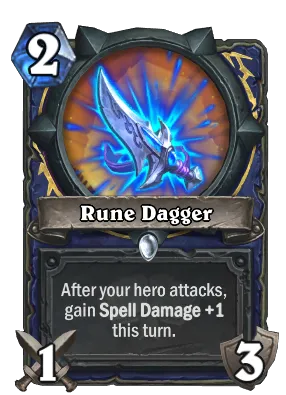
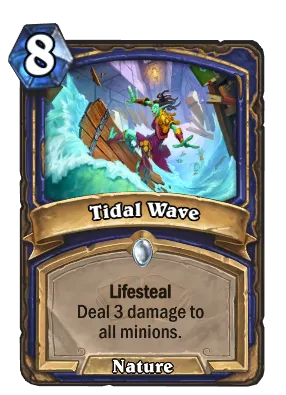
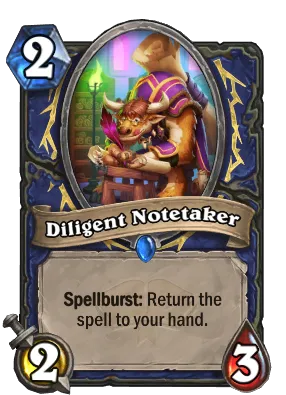
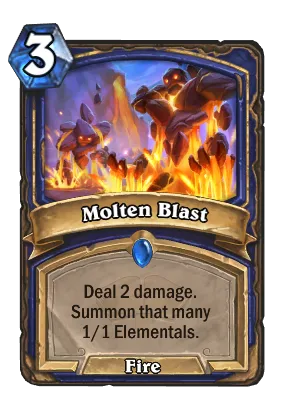
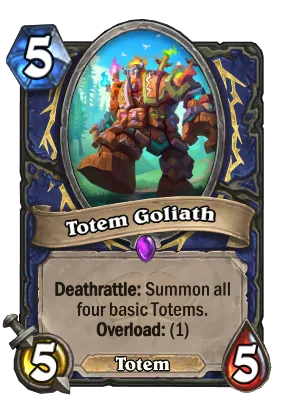
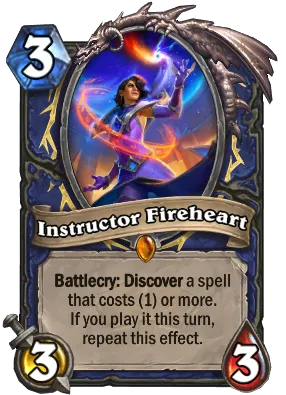




Comments
I applaud you for doing all that math for a single card. Thank you for your work.
I'm looking forward Diligent Notetaker followed up by Tidal Wave for late game shenanigans. The squelching that would happen immediately after that would be worth it. Granted, that may only really help you in situations where you were able to drag it out a long time without dying and you opponent having a rampant low health board... it still would be pretty satisfying to get off even if only for the meme.
I don't believe that works - spellburst triggers after the spell.
There in lies the fun, the spellburst should trigger as you cast the spell following stack rules.
Knowing my luck, I will discover that unicorn in space xD thanks for the maths ... and the warning :D
Nice review as always! I'm kinda sad that there were no evolve effects, since they would have been a great fit for magical experimentation.
Okay, that's a lot of math you did there, but not entirely enough. I'll explain what you could do there. (wrote a statistic test just yesterday and haven't gotten it out of my system yet)
So the probability to not get a card of this mana cost to the power of three - the probability to not get any card of this mana cost in your 3 choices. And then you substract the number from 1 to get the probability for at least one of this cost.
In an example, let's take compute the probability for at least one card of cost 3: For one card, the p. to not get one of cost 3 is: 72.73%. 0.7273³=0.3847 1-0.3847=0.6153. So the probability to get a card of cost 3 is: 61.53%
So I'll just do all the math, okay? Feel free to take it or leave it.
[/spoiler]
This is definitely more high-level than I could have done :D They don't teach me statistics in sound design!
Before I do the math (sorry I love statistics), in your calculations are you taking out the percentages as being the x-cost being the lowest discover option, or merely the chances of it being there? Cause this can influence the chain right? I might get offered 1 bad 1 cost, and 2 8's in standard for example, but it won't matter so much, so long as I take the 1-cost?
P.S. Love all these class review articles.
The chances of it being there, I converted the 1/72 chance to be how much out of a hundred, as percentages are easier to understand and a better visual marker than fractions. The percentages show the chance a card of x cost has a chance of showing up, regardless of whether it is good or bad card, and the entire calculation as a whole servers the singular purpose of providing an understanding of how often you should encounter cards of x cost on average. They likely won't feel accurate on a per-game basis, but over - let's say - at least 100 Discoveries. I would actually be curious if anyone could document their first 100 Discoveries with Fireheart and share the results of how many cards of each cost they got offered, then compare it to the math in the review! (or your math, if it turns out to be more accurate :D)
In terms of chain influencing, as I mentioned, the percentages become ever so slightly skewed when the Discover does its calculations. There is one factor to this I do not have enough information on: Whether all 3 cards in the Discover effect are chosen at once, or whether the game chooses them sequentially.
Since a Discover effect cannot offer the same card twice, I assumed that the game chooses which cards show up sequentially: Card one has its "native" chance to show up (1/72), card 2 has a 1/71 chance, and card 3 has a 1/70 chance (if we go by the Wild numbers). As described above, mana-cost wise, each card that shows up will affect the chances of every other card being offered in slots 2 and 3.
What I didn't mention is the following:
If, for example, a 1-cost card shows up in slot 1 of the Discover effect, then two things happen: 1-cost cards as a whole lose a percentage of their chance of showing up as the pool of 1-cost cards lose one of their cards.
Overall, every card that costs something other than 1 gets a slight boost to showing up. But due to the pool of 1-costs being smaller, 1-cost cards have a slightly smaller chance of showing up, while the rest of the card costs have a slightly higher chance of showing up. These changes in value are still quite negligible, however.
I hope I unpack the instructor so I can run tests over discoveries and see what they give. This seems like such an interesting card to my mind :)